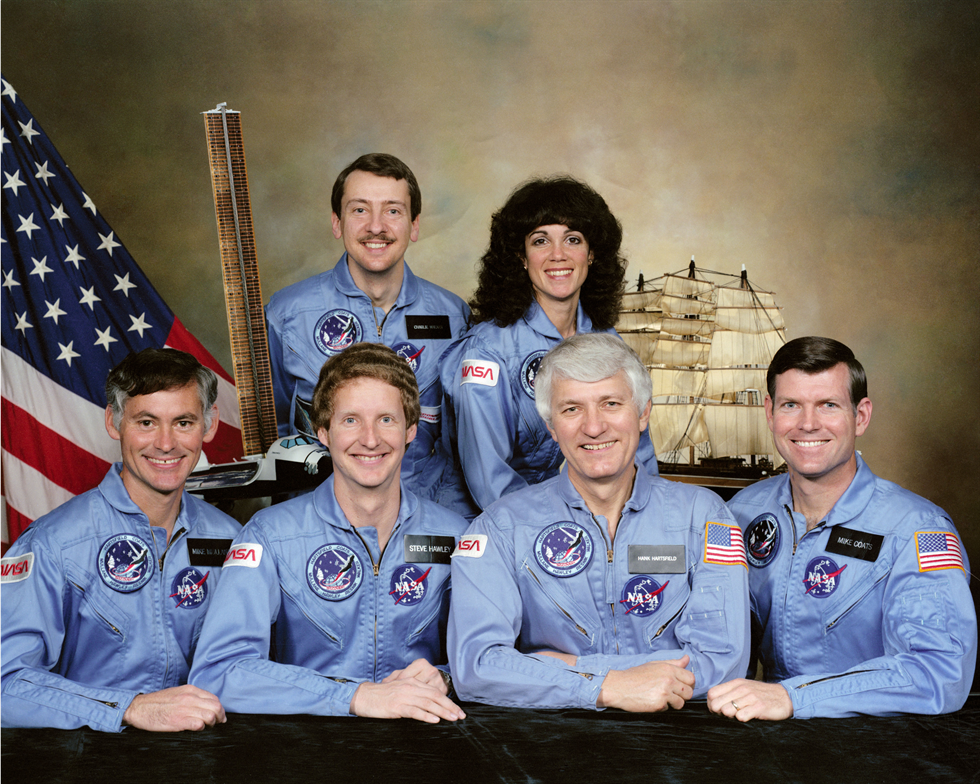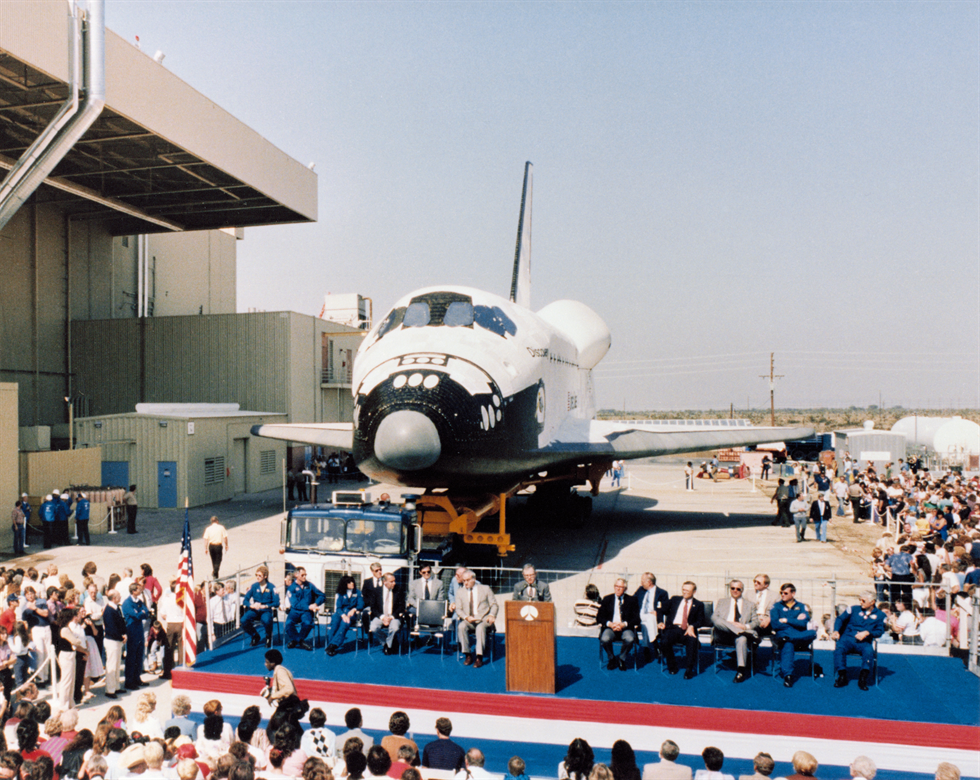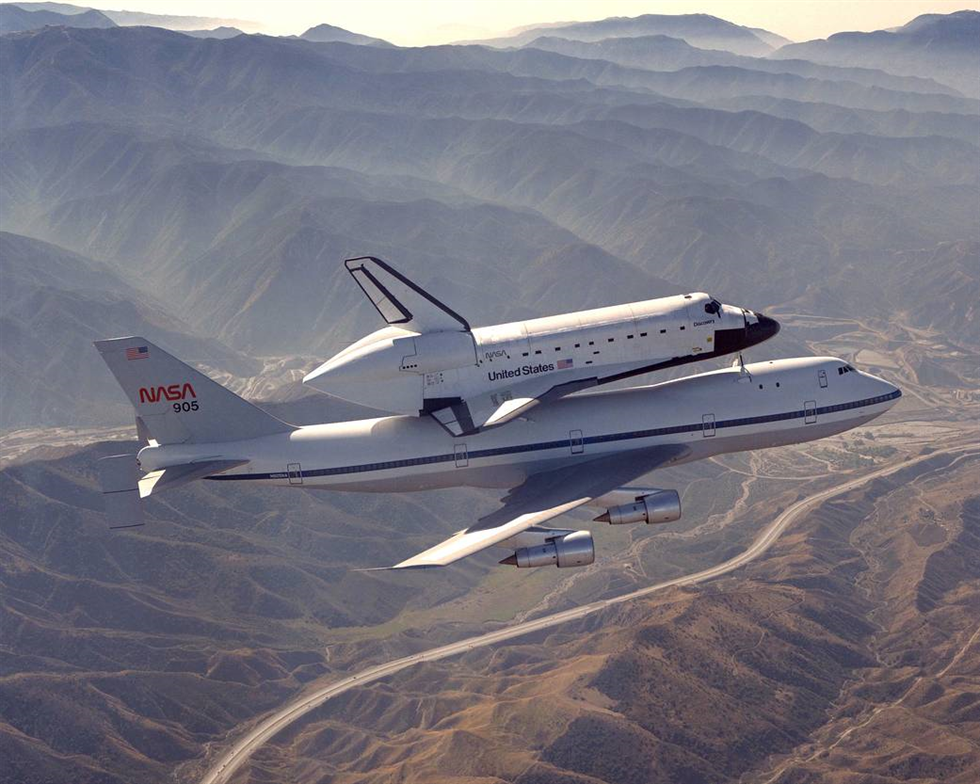Thirty-Five Years Ago: First Flight of Discovery
Space Shuttle Discovery, named after several historical ships of exploration, was the third space-qualified orbiter to be added to the fleet. Incorporating manufacturing lessons learned from the first orbiters, as well as through the use of more advanced materials, Discovery weighed nearly 8,000 pounds less than its sister ship Columbia.
Discovery rolled out of Rockwell International’s plant in Palmdale, California, on Oct. 16, 1983, arriving at NASA’s Kennedy Space Center on Nov. 9 after a cross-country ferry flight from Edwards Air Force Base (AFB) atop the Shuttle Carrier Aircraft (SCA), a modified Boeing 747. After ground processing, Discovery was mated to its external tank and Solid Rocket Boosters (SRBs) in the Vehicle Assembly Building (VAB), rolling out to Launch Pad 39A on May 19, 1984. A Flight Readiness Firing, an 18-second test of the shuttle main engines conducted before the first flight of an orbiter, was successfully completed on June 2.
Assigned to Discovery’s first flight, designated STS-41D, were Commander Henry W. Hartsfield, a veteran of the STS-4 mission; Pilot Michael L. Coats; Mission Specialists R. Michael Mullane, Steven A. Hawley and Judith A. Resnik; and Charles D. Walker, an employee of the McDonnell Douglas Corporation, flying as the first commercial payload specialist. Walker was added to the crew to operate the company’s Continuous Flow Electrophoresis System (CFES) experiment.
The primary payloads for the mission were three commercial communications satellites: SBS-4 for Small Business Systems, Telstar 3C for Telesat of Canada, and Syncom IV-2, also known as Leasat 2, for the U.S. Navy. Another payload in the cargo bay was the OAST-1 solar array, sponsored by NASA’s Office of Astronautics and Space Technology. The device was a 102-foot-long extendable and retractable panel containing different types of experimental solar cells. At the time, it was the largest structure deployed from a crewed space vehicle, and shuttle thruster firings tested the dynamic stability of the array wing.
The combined cargo weighed 41,184 pounds, the heaviest of the Space Shuttle Program up to that time. A large-format IMAX® camera, making its second trip into space aboard the shuttle, was in the middeck to film scenes both inside the shuttle and out the windows.
The first launch attempt on June 25, 1984, was delayed by one day due to the failure of the shuttle’s backup General Purpose Computer (GPC). The June 26 attempt was halted just four seconds before liftoff, when the GPC detected a fault in one of the shuttle’s three main engines and shut them all down. It was the first time a human spaceflight launch experienced an abort after the start of its engines since Gemini 6 in October 1965. The abort necessitated a rollback to the VAB on July 14, where Discovery was de-mated from the external tank and SRBs. The faulty engine was replaced, and Discovery rolled back out to the pad on Aug. 9 for another launch attempt on Aug. 29. That attempt was delayed by one day due to a software issue.
Left: Initial rollout of Discovery from
the VAB. Right: June 26 launch abort. Image Credits: NASA
Left: Payloads
installed in Discovery's payload bay
for the STS-41D mission (top to bottom) OAST-1, SBS-4, Telstar 3C and Syncom
IV-2. Right: Launch of Discovery on
the STS-41D mission. Image Credits: NASA
Finally, on Aug. 30, 1984, Discovery roared off the launch pad on a pillar of flame and, within eight minutes, was in orbit around Earth. The crew got down to work and, on the first day, Mullane and Resnik deployed the SBS-4 satellite. On the second day in space, they deployed the Syncom satellite, the first satellite designed specifically to be launched from the shuttle. On the third day, the crew deployed the Telstar satellite, completing all satellite-delivery objectives of the mission. Resnik then deployed the OAST-1 solar array to 70% of its length to conduct dynamic tests on the structure. On the fourth day, she deployed the solar array to its full length and successfully retracted it, completing all objectives for that experiment.
Astronauts deploy (left
to right) SBS-4, Syncom IV-2/Leasat-2 and Telstar 3C during STS-41D. Image
Credits: NASA
Walker was busy with the CFES experiment. And, although the experiment experienced two unexpected shutdowns, he was able to process about 85% of the planned samples. The unit operated for about 100 hours. Hartsfield and Coats, meanwhile, exposed two magazines and six rolls of IMAX® film, recording OAST-1 and satellite deployments as well as in-cabin crew activities. Clips from the mission were used in the making of the 1985 IMAX® film, “The Dream is Alive.” On the mission’s fifth day, concern arose over the formation of ice on the orbiter’s waste dump nozzle. The next day, Hartsfield used the shuttle’s robotic arm to dislodge the large chunk of ice.
Left: Walker in front
of the CFES experiment. Middle: Hartsfield loads film into the IMAX® camera. Right: The crew of STS-41D poses in the middeck.
Image Credits: NASA
On Sept. 5, 1984, the astronauts closed Discovery's payload bay doors in preparation for reentry. They fired the shuttle’s engines to slow their velocity and begin a descent back to Earth. Hartsfield guided Discovery to a smooth landing at Edwards AFB, completing a flight of six days and 56 minutes. The crew had traveled 2.5 million miles, completing 97 orbits around Earth.
Left: The OAST-1 Solar Array Experiment extended from Discovery's payload bay. Right: Space Shuttle Discovery makes a perfect landing at Edwards AFB to end the STS-41D mission. Image Credits: NASA
Read recollections of the STS-41D mission by Hartsfield, Coats, Mullane, Hawley and Walker in their oral histories with the JSC History Office.
Enjoy the crew’s narration of a video about the STS-41D mission.











